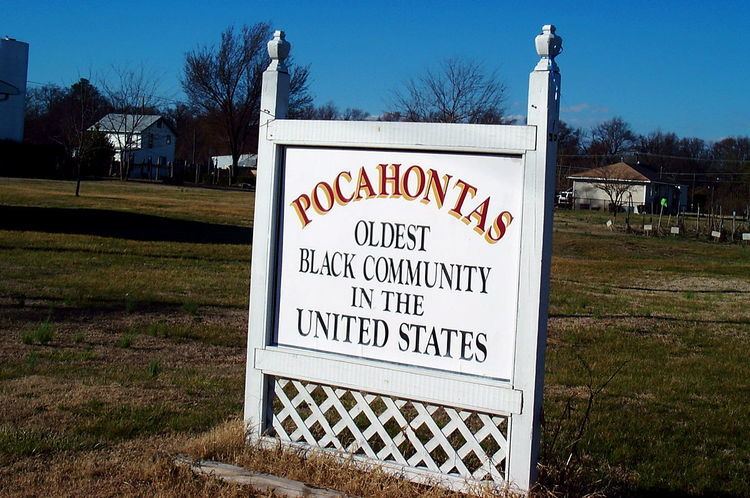Built 1952 VLR # 123-0114 Added to NRHP 3 November 2006 | NRHP Reference # 06000977 Opened 1952 | |
 | ||
Architect Lee, William Edward, Jr. Architectural style Federal, Bungalow/Craftsman Similar Gillfield Baptist Church, Blandford Cemetery, First Baptist Church, Union Station, Blandford Church | ||
The enduring legacy of pocahontas island
Pocahontas Island is a peninsula in Petersburg, Virginia; it is located on the north side of the Appomattox River. Archeological evidence has been found her of prehistoric Native American settlement dating from 6500 BC. The Appomattoc tribe occupied this area at the time of European-American settlement by English colonists.
Contents
- The enduring legacy of pocahontas island
- Promiseland pocahontas island trailer
- History
- Recognition
- References
In the 19th century, this area became notable as the first predominately free black settlement in the state and, by mid-19th century, one of the largest in the nation. In 1860 slightly more than half of Petersburg's population was black, and 3,224 or one-third of those people were free; they constituted the largest free black population of the time.
During the 20th century, the population declined as people moved north in the Great Migration. In 1975 residents secured renewed residential zoning to protect their neighborhoods from industrial development proposed by the city. The Pocahontas Island Historic District is listed on the National Register of Historic Places (NRHP) as a historic district. It is significant both for its African-American history and prehistoric indigenous archeological assets.
Promiseland pocahontas island trailer
History
Archaeological evidence of a prehistoric Native American community dated to 6500 BC has been found on the island. This is at the beginning of the Middle Archaic Period (6500 BC to 3000 BC) or end of Early Archaic Period (8000 BC to 6500 BC)
When English colonists first arrived in Virginia in 1607, the Appomattoc tribe of the Powhatan Confederacy had this area within their territory. English colonial settlement on the peninsula started in the 18th century. Some of the first enslaved Africans were brought here in 1732 to work in John Bolling's tobacco warehouses. Surveyors platted the land in 1749, and settlers named the village Wittontown. When formally organized as a town in 1752, it was renamed Pocahontas after the Native American daughter of Powhatan, who was important to colonial history and, together with her English husband, became an ancestor of numerous First Families of Virginia.
In 1757 Petersburg built a bridge to link the peninsula to the city. In the early years a board of trustees managed the "island" and its development. Incorporated within the city limits in 1784 after the American Revolutionary War, the Pocahontas Island neighborhood became a center of a free black population. It was often neglected afterward by city government, which was more concerned with development in white areas.
The neighborhood became the center of a large free black residential community, the oldest in the nation and a destination for free blacks in the state. They developed a commercial center in this area as well. One of the first black congregations was known here as the Sandy River Baptist Church, which later moved into the center of Petersburg and built the Gillfield Baptist Church. The growth of industrial jobs attracted free blacks to Petersburg; it was also a place where artisans and craftsmen could make a living. Other men worked as boatmen and fishermen on the river.
Numerous antebellum houses exist. Two surviving houses were linked to the Underground Railroad before the American Civil War: the Jarratt House, 808-810 Logan Street, and 215 Witten Street, informally called the Underground Railroad House. By 1860, the city's population was half black - of those, one-third were free. It was the largest free black population in the nation.
Archaeological evidence has been found relating to this period of majority-black residency, as well as of industrial activity. For instance, researchers found remains of a depot of the Richmond & Petersburg Railroad, a building 30 feet by 300 feet. It was important for the transport of Confederate troops during the American Civil War.
Employment cycles after the war continued to affect less educated blacks more severely. It took decades for the city to rebuild after the American Civil War. Increasing industrialization provided continued opportunities for blacks, even though the white-dominated Virginia legislature imposed racial segregation and disfranchisement in the late 19th century. Largely excluded from the political system, blacks created their own opportunities.
In the 20th century, the more ambitious and younger people tended to leave the island (and many southern states) for other opportunities. The Great Migration to northern industrial cities, starting about World War I, is the time Islanders refer to as "when they lost the 'cream of the crop', with the majority of the remaining population being elderly retirees who sustain themselves on small fixed incomes." The neighborhood shared economic troubles with the city, which lost jobs to other areas and increasingly to Richmond. The capital became the region's and state's financial center.
In 1971 the Petersburg city government rezoned some of the island for light industrial use. This caused the homes of 250 residents to be threatened with condemnation, making it impossible for owners to get financing for renovations. In 1975 residents won a battle to restore residential zoning. Allied groups began to survey and document the many historic properties. The Pocahontas Island Historic District was added to the National Register of Historic Places because of its abundance of archaeological sites from prehistory through historic times, and of numerous antebellum buildings marking its history as a free black community.
A 1993 tornado severely damaged some houses. By the late 20th century, the population had declined to fewer than 100 on the island from a high of 1700 earlier.
Recognition
Because of its significant resources, ranging from prehistoric to historic, the Pocahontas Island Historic District is listed on both the Virginia Landmarks Register and the National Register of Historic Places (NRHP). It is also the location of the Pocahontas Island Black History Museum.
